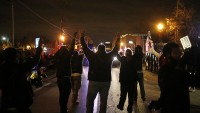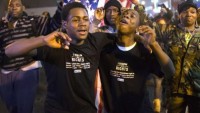Darren Wilson's Deadly Encounter With Michael Brown a Case of Age-old Bias
| Winona Cueva | | Nov 26, 2014 02:08 AM EST |
(Photo : REUTERS) Ferguson protests after Grand Jury decision
Darren Wilson's testimony on his encounter with Michael Brown raises the red flag on what behavioral and security experts call White cops' mindset about Black people when responding to crime in a Black-dominated neighborhood.
The issue is not one that can simplistically be considered 'racist', but rather a set of perceptions about blacks likely programmed in the American mind over time, even dating back to the age of slavery.
Like Us on Facebook
Mindsets or built-in perceptions leave no room for further thought during an altercation. They often translate to gut responses, and can prod a responding white police officer to use brutal force on a Black suspect.
"Perhaps people assume that Blacks possess extra strength, which enables them to endure violance more easily than other humans," said the authors of a Northwestern University study that looked into Whites' biased perception of Blacks.
In his testimony before the Ferguson Grand Jury, Wilson described Brown as a "rage-filled demon" who was about to lunge at him. He also described Cantile Drive, the scene of the encounter with Brown, as a place known to be "hostile" to police.
This part of the Ferguson testimony was likely interpreted by the Grand Jury as justication for Wilson to act in defense of his own life and safety, a situation that the courts favorably consider when weighing a defendant's culpability.
The Grand Jury late Monday decided not to indict Wilson over the death of Brown following months of sifting through evidence and testimonies on the August 9 fatal encounter.
Brown's death has sparked violent protests for months, picking up steam again just minutes after the Grand Jury released its verdict late Monday.
This time, the protests were not confined in Ferguson, Missouri but had spilled to other places such as New York, Chicago, Boston, and California.
Many of the protesters who rallied behind Michael Brown from anywhere in the country viewed the Ferguson case as "something personal".
For New Yorkers, it was as much a sympathy for Brown as it was for police chokehold victim Eric Garner who was manhandled by NYPD officers July this year.
The California protests were reminiscent of the 1992 riots over the death of Rodney King, a victim of police brutality in Los Angeles whose aggressors were likewise acquitted.
Just this week, protest initiatives were gaining ground over the fatal shooting of 12-year-old Tamir Rice by Cleveland cops, all because he carried a toy gun and was perceived as a potential threat.
While President Obama and other level-headed pundits invariably caution against seeing color in the Ferguson incident, there is no denying that it has opened the floodgates of old racial wounds that have plagued the country for centuries despite countless libertarian discourse on equality.
Experts warn that a lingering biased perception of Blacks and Black neighborhoods is a legitimate cause for concern when it creeps into White law enforcers' instantaneous decisions on whether or not to use brutal force on crime suspects.
©2015 Chinatopix All rights reserved. Do not reproduce without permission
EDITOR'S PICKS
-

Did the Trump administration just announce plans for a trade war with ‘hostile’ China and Russia?
-

US Senate passes Taiwan travel bill slammed by China
-

As Yan Sihong’s family grieves, here are other Chinese students who went missing abroad. Some have never been found
-

Beijing blasts Western critics who ‘smear China’ with the term sharp power
-

China Envoy Seeks to Defuse Tensions With U.S. as a Trade War Brews
-

Singapore's Deputy PM Provides Bitcoin Vote of Confidence Amid China's Blanket Bans
-

China warns investors over risks in overseas virtual currency trading
-

Chinese government most trustworthy: survey
-

Kashima Antlers On Course For Back-To-Back Titles
MOST POPULAR
LATEST NEWS
Zhou Yongkang: China's Former Security Chief Sentenced to Life in Prison

China's former Chief of the Ministry of Public Security, Zhou Yongkang, has been given a life sentence after he was found guilty of abusing his office, bribery and deliberately ... Full Article
TRENDING STORY

China Pork Prices Expected to Stabilize As The Supplies Recover

Elephone P9000 Smartphone is now on Sale on Amazon India

There's a Big Chance Cliffhangers Won't Still Be Resolved When Grey's Anatomy Season 13 Returns

Supreme Court Ruled on Samsung vs Apple Dispute for Patent Infringement

Microsoft Surface Pro 5 Rumors and Release Date: What is the Latest?












